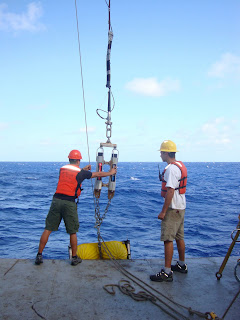And watching from the camera tripod. We now know the temperature of the water from which your blubber insulates you, and its dissolved oxygen concentration too. We know how the currents will softly push you – in fact we know the whole profile of 100’s of meters of current starting at the bottom and working up. In a few years, we’ll know the temperature profile of the bottom 200 m too – and watch out because the thermistors are already sensing. As of about noon today, the Aloha Cabled Observatory is officially observing. So when you pass through here next winter and spring, consider yourselves warned that we will be eavesdropping on you in real time.
My 0400 watch started slowly. The first half an hour was spent finishing snapping photos of the all the parts in their respective places– the AMM, the TAAM, the eyeball, the J-box, the cable termination and the observatory. These photos will then be collaged together to make a mosaic of the equipment at the seafloor. The rest of the watch was filled with waiting – waiting for 0700 when the land dwellers could enter Makaha Cable Station and tell us if the final configuration of the J-box was worth the last couple yo-yo trips up and down. Overnight, the J-box had been set in place and connected to the cable termination and the observatory as planned.
0800 came and there was still no news from Makaha. A phone rang now and again but apparently nothing of importance to relay to the rest of the van. Off watch, I waited in the lab watching Channel Jason unwavering from its zoom on the J-box connector configuration.
Good but uncertain news began to trickle in. First Chris, passing through the lab, told me that they got a good signal. “What kind of a signal?” He couldn’t tell me for sure so I kept my hopes at bay. It could have been the same good power signal we’ve always had.
Next Roger came in telling me, “We have ears.” Thinking that one would need eyes, not ears, to receive an optical signal, I was confused. He clarified: ears meant hydrophones; the hydrophones were on and sending data to Makaha. “We’re listening right now.” The hydrophones are on the J-box, which means that the J-box’s signal is getting through. This is half the good news that we have been on edges of our seats staring longingly at Channel Jason in hopes of seeing. The second half of the good news is on the other side of the J-box: the observatory, the AMM and the camera. We would have to wait another couple of hours through testing to know that these components work as well. By turning off Jason’s Times Square array of lights, we could see the LED light on the observatory shine on command from Makaha. The AMM, through which the camera communication is routed, was misbehaving so its connector had to be switched to the observatory. By 1400, an email containing the first pictures taken by Joseph on land through the eyeball had circulated around the ship. Though the low light produced a fairly low quality photo compared to what the camera is capable of, this black and white photograph was like an ultrasound – proof of what’s to come.

At 1600, my watch came around as it typically does – except this time would be the last. All the connections had been made; the observatory was already getting to know the ocean all on its own. What was left was another test of the camera – this time to take photos of Jason – and some steward-ly housekeeping. Jason lifted off and did a victory lap of the area being sure to show his good side to the camera. He picked up the ADP protective trashcans, which that pesky gravity tried to pull off the Jason’s basket several times before Jason, refusing to litter, pinned in down with his fist. His last task of retrieving the bridle proved as pesky as the trashcans but Scott worked some magic in the mud with both manipulator arms at once and secured it around the trashcans. As Jason came back to the surface, I missed a half an hour of my last water column to grab an elegant last meal of stuffed lobster tail and rosemary marinated filet mignon followed by Baked Alaska. The delight in the galley was a perfect parallel to the delight buzzing around the ship at the success of the day.
When Jason arrived back on deck after dinner, all hands gathered for a group photograph under the A-frame. There is packing to be done and finalizing work. But above the hands coiling cables hopefully not be seen for quite some time, above the shoulders carry out boxes of tools to be unloaded from the ship tomorrow, turning from the necks that have been hunched over computer screens and wires for the last two weeks are faces whose grins are forcing aside the tired and perhaps peeved frowns from before. I sat on the 0-2 deck as the twilight turned dark and we motored away from Station Aloha. It’s odd to think that the contents of the quarterdeck are sitting in the dark, in the mud at the bottom of the ocean. It’s odd to think that those hunks of titanium, o-rings, battery packs, thin strands of glass and wire are clicking away. It’s odd to know that they are talking to other hunks of metal and wires at Makaha and Manoa. But all of this oddity sums to the miraculous reality of a location being observed without the observer. As the ship’s company heads to their bunks one by one, and hopefully those on land follow suit, the observatory won’t notice the difference that night makes. It tirelessly will continue sensing and sending data to land for the next three to four years.
































